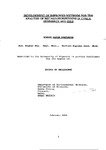DEVELOPMENT OF IMPROVED METHODS FOR THE ANALYSIS OF METALLOPORPHYRINS IN COALS, SEDIMENTS AND OILS
| dc.contributor.author | PRETORIUS, WARREN GAVIN | |
| dc.contributor.other | School of Geography, Earth and Environmental Sciences | en_US |
| dc.date.accessioned | 2013-10-14T08:54:49Z | |
| dc.date.available | 2013-10-14T08:54:49Z | |
| dc.date.issued | 1994 | |
| dc.identifier | NOT AVAILABLE | en_US |
| dc.identifier.uri | http://hdl.handle.net/10026.1/2192 | |
| dc.description.abstract |
A high temperature gas chromatography (HTGC)-inductively coupled plasma-mass spectrometry (ICP-MS) interface was successfully developed which allowed the analysis of metalloporphyrins (Retention Index >6000), with detection limits of less than 1 nanogram on column. The system was used together with conventional HTGC-flame ionization detection and HTGC-mass spectrometry (MS) for the analysis of geoporphyrin fractions from Julia Creek, Serpiano, Marl Slate and Green River shales. This allowed the rapid fingerprinting of the metals chelated to the porphyrins in these samples. Previously unreported titanium porphyrins were detected in two of these shales, the Marl Slate and Julia Creek. An iron porphyrin fraction from Bagworth coal was also examined for the first time using both HTGC-ICP-MS and HTGC-MS and the distributions of the ETIO porphyrins calculated. The HTGC method was found to be useful only for qualitative scanning of the geoporphyrin fractions. This was due to problems with the stability of the gas chromatographic columns used for these analyses. The columns used were found to last between 5 and 10 injections, after which the porphyrins appeared as broad humps, slowly eluting off the column. A high performance liquid chromatography (HPLC)-ICP-MS method was developed to allow the quantitative analysis of geoporphyrins, which was not possible with the HTGC-ICP-MS method. The HPLC-ICP-MS interface used allowed good chromatographic separation to be achieved, with less than 10 % loss in column efficiency. This system was used for the quantitative analysis of gallium and nickel porphyrins from coals and shales respectively. The qualitative distributions obtained for the geoporphyrins using HPLC-ICP-MS showed good agreement with the HPLC-UV/VIS results. A GC-Low Pressure-ICP-MS interface was designed and constructed and the analysis of metalloporphyrins attempted. The metalloporphyrins were not successfully eluted through the GCLP- ICP-MS system. However, a number of more volatile organometallic compounds were analysed (tetraethyl lead, ferrocene and tetrabutyltin). Interestingly the system also produced fragment molecular ions of chlorobenzene, bromobenzene and iodobenzene at low plasma powers (-10 W), using the carrier gas as the plasma gas (helium). Thus the system could be used to obtain both atomic and molecular spectra, which has not been achieved previously. | en_US |
| dc.language.iso | en | en_US |
| dc.publisher | University of Plymouth | en_US |
| dc.title | DEVELOPMENT OF IMPROVED METHODS FOR THE ANALYSIS OF METALLOPORPHYRINS IN COALS, SEDIMENTS AND OILS | en_US |
| dc.type | Thesis | |
| dc.identifier.doi | http://dx.doi.org/10.24382/3836 | |
| dc.identifier.doi | http://dx.doi.org/10.24382/3836 |
Files in this item
This item appears in the following Collection(s)
-
01 Research Theses Main Collection
Research Theses Main


